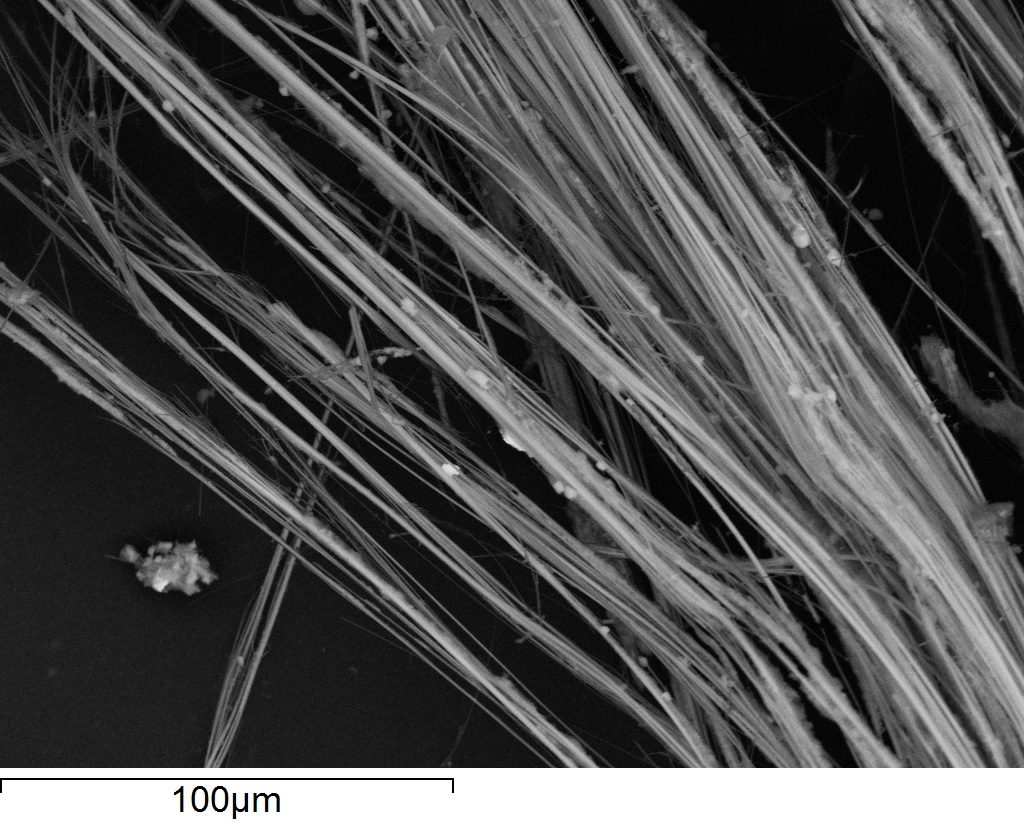With asbestos fibres, the diameter is small enough to enter the macrophage but the fibre is long enough that it can’t close its ‘mouth’. Because the fibre is not dissolved by the surrounding fluids (it is bioinsoluble), this prevents the macrophage from doing its job and removing the fibre and kills the macrophage in the process. This results in scarring and can eventually lead to mesothelioma and other lung cancers.
This relationship between the diameter:length aspect ratio and the ability of the fibre to kill macrophages is the reason that the fibre definitions for different industries are based on aspect ratio. The three main definitions of a countable asbestos fibre are:
- DMP (Department of Mines and Petroleum): < 1 µm diameter, > 5 µm length
- NOHSC: < 3 µm diameter, > 5 µm length, aspect ratio of > 3:1
- USEPA: > 10 µm length, aspect ration of > 3:1, substantially parallel sides
The other property of the fibres that is significant is the mineralogy, as some minerals are biosoluble (the surrounding lung fluid will dissolve the fibre anyway, even if it isn’t disposed of by the macrophage). Only the bioinsoluble minerals pose a health risk.
Only six different minerals are classified as asbestos. Chrysotile, Crocidolite (asbestiform Riebeckite), Amosite (asbestiform Grunerite), Actinolite, Tremolite and Anthophyllite (asbestiform Cummingtonite). All of these minerals were once sold commercially as asbestos, but they aren’t the only minerals with these properties. Later, it was discovered that other minerals with the same high aspect ratio and bioinsolubility caused the same kind of diseases. Some other hazardous fibres include Winchite, Richterite, and Erionite.
There are also a significant number of minerals that have the same morphology (high aspect ratio fibres) but don’t pose the same risk as the fibres simply dissolve. Some examples are Epsomite, Ettringite, Halotrichite and sometimes simple Halite, or table salt, can form similar fibres.
So how do you tell them apart? That’s where we come in.
Optical microscopy has historically been used for identifying fibrous materials. It’s quick, cheap and doesn’t require much sample preparation so it’s ideal for a quick check for fibres. However, it has some notable limitations:
- Optical miscroscopy has magnification limits which mean that very fine, highly toxic fibres (< 0.5µm in diameter) are unable to be detected;
- Optical microscopy can tell limited information about the mineralogy, so often can’t differentiate between biosoluble and bioinsoluble minerals; and
- Although Polarised Light Microscopy (PLM) can differentiate some types of asbestos using oils of specific optical properties, the technique can’t identify all types, and can’t identify other minerals, hazardous or otherwise.
Scanning Electron Microscopy ( SEM) with Energy Dispersive X-ray Spectroscopy (EDS) can take very high resolution, high magnification images that clearly depict very fine fibres. The EDS determines the elemental composition, which can pinpoint the mineralogy of the fibres and identify whether they fall into the hazardous, bioinsoluble category. In some cases, multiple minerals have very similar elemental composition, and X-ray Diffraction ( XRD) can be used to confirm the mineral assignment.
* approximately 30 years laterNimue Pendragon
|

